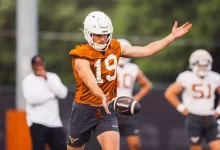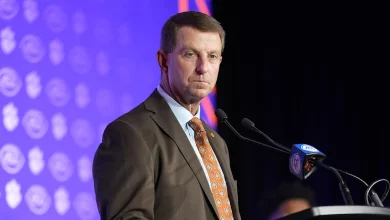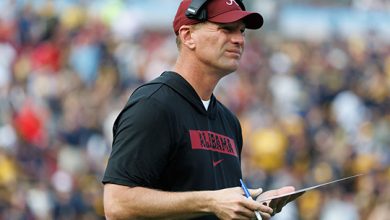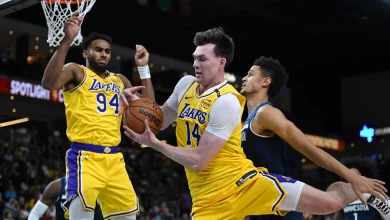How Ashley Chastain, the new coach, assembled the USC softball team before the season

How Ashley Chastain, the New Coach, Assembled the USC Softball Team Before the Season
When Ashley Chastain took the reins as the head coach of the USC Trojans softball team, there was an air of anticipation and excitement surrounding the program. A fresh approach, a new energy, and a renewed sense of purpose were just some of the things Chastain was expected to bring to the table. Known for her sharp coaching acumen, her passion for the game, and her ability to build competitive teams, Chastain’s appointment as head coach was seen as the start of a new chapter for USC softball.
Assembling a competitive and cohesive team from scratch is never an easy task, especially when inheriting a program that has its own set of challenges. But Chastain, a coach with a proven track record in recruiting and player development, quickly set about creating a team that could compete for championships while also maintaining the Trojan tradition of excellence. This article explores how Chastain approached building the 2024-2025 USC softball team, from recruiting to shaping the team’s culture, and the vision she had for the program going into the season.
The Foundation: Understanding the Program’s Needs
Before Chastain could start assembling the roster, she needed to understand the state of the USC softball program, both in terms of its talent pool and its overarching goals. After taking over the program, she immediately immersed herself in evaluating the current players, learning about their strengths and weaknesses, and identifying key areas that needed improvement. Chastain had the advantage of being familiar with the culture of USC athletics, having spent time in the Pac-12, and she knew that she needed to build a team that could both compete at the highest level and embody the ideals of Trojan athletics.
She spent hours reviewing film, meeting with assistant coaches, and speaking to players. This gave her a clear picture of the program’s existing talent and where there were gaps. It also allowed her to get a better sense of the mentalities, personalities, and work ethics of the returning players. With this information, Chastain was able to make informed decisions about how to fill the gaps on the roster, both in terms of skill and character.
In addition to recruiting new players, Chastain emphasized the importance of building a unified, resilient team culture. She wanted players who not only had strong technical skills but who also had a winning mentality, work ethic, and the drive to push themselves and their teammates toward excellence. For Chastain, talent alone wasn’t enough—team cohesion and the right mindset were just as critical.
Recruiting for the Future: A Focus on Talent and Depth
Once Chastain had a sense of the current roster’s composition and needs, the next phase of team building focused on recruiting new talent. Chastain knew that USC’s softball program needed a blend of experienced players who could contribute immediately and younger players who could develop over time. She set out to recruit players who could fill specific roles on the team, but also those who would fit into her long-term vision for USC softball.
One of Chastain’s early recruiting strategies was to focus on building depth in all positions. She made sure to recruit players who could fill gaps in pitching, hitting, and defense. Rather than focusing solely on high-profile players, Chastain looked for recruits who were versatile, coachable, and hungry to make an impact at the college level.
Pitching Staff: A Strong Foundation
As with any successful softball team, Chastain knew that building a competitive pitching staff would be one of her top priorities. USC had some promising pitchers already on the roster, but Chastain aimed to bring in new talent to create a deeper, more dynamic pitching rotation. After assessing the program’s pitching needs, Chastain and her staff scouted high school and junior college pitchers who had the potential to step in and make an immediate impact.
She added a few key players to the pitching staff, including a top-rated freshman and a transfer from a competitive program. The freshmen brought in raw talent and energy, while the transfer had a wealth of experience in big games and could help provide leadership to the younger pitchers. Chastain’s emphasis on pitching depth allowed her to create a staff capable of handling the rigors of a long season and performing at a high level in the postseason.
Position Players: Building Versatility and Power
Chastain didn’t just look for players to fill traditional roles—she was intent on recruiting athletes who could adapt to various positions and situations. She sought versatile position players who could provide depth across the infield, outfield, and behind the plate. In particular, she looked for players with the ability to hit for both power and average, as well as those who could field at multiple positions.
One of Chastain’s key additions was a highly-touted infielder with exceptional defensive skills and a powerful bat. This player could play several positions, allowing Chastain to be flexible with her lineup. Another recruit was a speedy outfielder who could contribute in the leadoff spot and provide a spark on offense with her baserunning. Adding players like these made USC’s lineup dynamic and allowed Chastain to build a team that could both manufacture runs and slug its way through tough games.
In addition to filling specific needs, Chastain also emphasized the importance of recruiting players who demonstrated strong leadership qualities, work ethic, and the ability to stay calm under pressure. She wanted players who would be able to rise to the occasion in big games and perform well in the most crucial moments of the season. Whether it was a clutch hit, a key defensive play, or a big strikeout, Chastain sought recruits who had the mental toughness to thrive in high-stress situations.
The Impact of Transfers and Graduate Players
To round out the roster, Chastain also focused on adding experienced transfers and graduate players who could provide immediate leadership and elevate the team’s competitiveness. These players brought with them a wealth of experience playing in other programs, and they were able to step in and make an immediate impact.
One notable addition was a graduate transfer catcher who brought with her a strong defensive presence behind the plate and the ability to call a game. Her experience with high-level competition allowed her to quickly integrate into the team and become a key leader both on and off the field. Transfers like this were invaluable in giving the Trojans a much-needed boost of experience and leadership, while also adding to the team’s overall depth.
Developing Team Chemistry: Building a Winning Culture
While assembling a talented roster was essential to Chastain’s vision, building a cohesive and hardworking team was just as important. Chastain knew that a group of talented players would only succeed if they were able to play together, trust each other, and execute the game plan as a unit. To achieve this, she placed a heavy emphasis on team-building activities, leadership development, and establishing a culture of accountability.
Chastain focused on creating an environment where players were encouraged to push each other to be their best while also supporting one another through challenges. Whether through team workouts, group discussions, or team-building events, Chastain made sure that her players were not only growing as athletes but also as individuals. Her coaching philosophy centered on developing leaders within the team and fostering an atmosphere where everyone felt valued and motivated to contribute.
The team’s culture became one of resilience, focus, and determination. Chastain’s message to the players was clear: in order to succeed at USC, they needed to be relentless in their pursuit of excellence. She emphasized the importance of hard work, discipline, and a commitment to improving every day, both on the field and off it.
Looking Ahead: The 2024-2025 Season
As the 2024-2025 season began, it was clear that Chastain had successfully assembled a team that was not only talented but ready to compete. The combination of veteran leadership, strong transfers, and emerging young talent created a balanced and dangerous team capable of challenging for championships.
The season’s early performances confirmed that the new-look USC Trojans were ready for primetime. The pitching staff, which had been a key focus of Chastain’s recruitment, held its own against top-ranked teams, while the position players demonstrated the ability to hit for power and play solid defense. The team’s chemistry was evident as players celebrated each other’s successes and supported one another through adversity.
Chastain’s approach to assembling the 2024-2025 USC softball team was a blend of smart recruiting, player development, and culture-building. By focusing on both immediate talent and long-term potential, she crafted a team that could compete at the highest level while also ensuring sustainable success for years to come.









